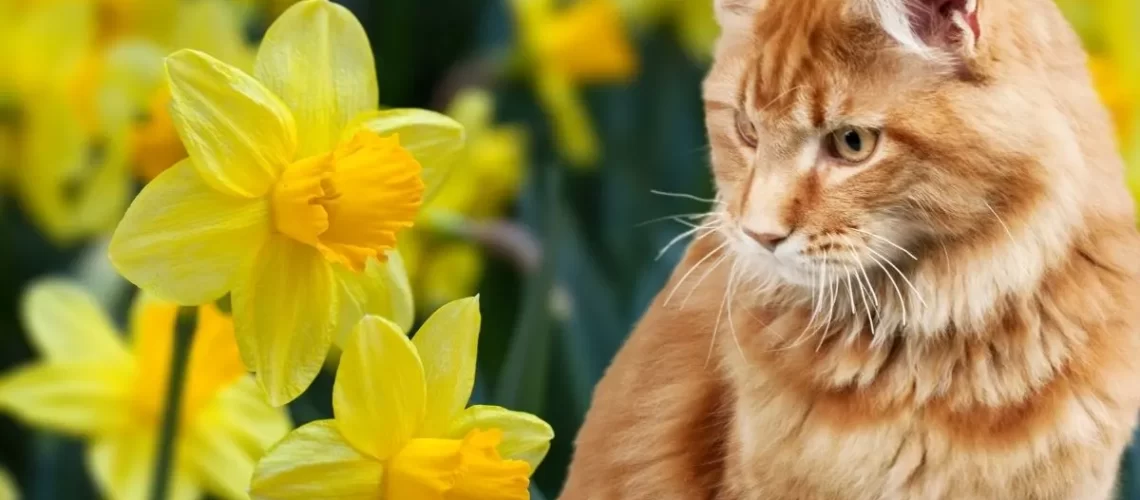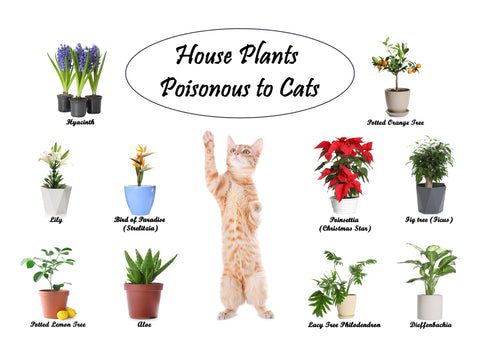Key Takeaways:
- Daffodils are a popular and beautiful flower, but they can be toxic to cats.
- All parts of the daffodil plant, including the bulbs, leaves, and flowers, contain toxic compounds called alkaloids.
- When ingested by cats, daffodils can cause symptoms such as vomiting, diarrhea, abdominal pain, and even more severe issues like cardiac arrhythmias.
- If you suspect your cat has ingested any part of a daffodil plant, it is important to seek veterinary care immediately.
- Preventing access to daffodils by keeping them out of reach or opting for cat-safe plants in your home will help ensure your pet's safety.
Are you a cat lover? Do you enjoy having beautiful flowers in your home? If so, then you need to pay attention to this important topic: daffodils. These vibrant yellow flowers may seem harmless and pretty, but did you know that they can be poisonous for cats? Understanding the dangers of daffodils is crucial for any cat owner who wants to keep their furry friend safe and healthy. In this article, we will explore why daffodils are a potential threat to our feline companions and how you can ensure their well-being while still enjoying the beauty of these flowers. So let's dive in and uncover the hidden dangers lurking among those delightful daffodils!
Can daffodils harm cats?
Daffodils can indeed harm cats if they are ingested. The entire plant, including the bulb, leaves, and flowers, contains toxic substances called alkaloids. These alkaloids can cause various symptoms of poisoning in cats, ranging from mild to severe. It is important to keep daffodils out of reach of your feline friend to prevent any accidental ingestion.
What are daffodils and why are they so pretty?
Daffodils are beautiful flowers that bloom in the spring. They have long, slender stems with a trumpet-shaped center surrounded by petals. The trumpet can be yellow, white, or orange, while the petals are usually a lighter shade of the same color. Daffodils come in different varieties and sizes, but they all share the characteristic beauty that makes them so popular.
One reason why daffodils are considered pretty is because of their vibrant colors. The bright yellows and whites can instantly catch your eye and bring joy to any garden or bouquet. Their elegant shape and delicate fragrance also add to their appeal. Daffodils symbolize new beginnings and rebirth, making them especially meaningful during the spring season when nature comes alive again after winter.
The Different Types of Daffodils
Daffodils belong to the Narcissus genus, which includes various species and hybrids. Here are some common types:
- Trumpet Daffodils: These have a large trumpet-shaped center that is longer than or equal to the length of the petals.
- Large-Cupped Daffodils: Their cup-shaped centers are smaller than the petals but still prominent.
- Small-Cupped Daffodils: These have small cups that contrast with the larger petals.
- Double Daffodils: They have multiple layers of petals, giving them a fuller appearance.
- Miniature Daffodils: These are smaller versions of regular daffodils, perfect for pots or rock gardens.
The Life Cycle of a Daffodil
A daffodil's life cycle begins with a bulb planted in autumn. Over winter, it remains dormant underground until spring arrives. As temperatures rise and daylight increases, the bulb starts to sprout. A green shoot emerges from the soil and grows taller, eventually forming a bud.
Once the bud matures, it opens up into a beautiful flower. Bees and other insects are attracted to the daffodil's bright colors and sweet fragrance, helping with pollination. After the flowers fade, they are replaced by seed pods that contain daffodil seeds. These seeds can be used to grow new daffodil plants or left in the ground to naturalize over time.
Symptoms of daffodil poisoning in cats
If a cat consumes parts of a daffodil plant, they may exhibit certain symptoms that indicate poisoning. These symptoms include vomiting, diarrhea, drooling excessively, abdominal pain, loss of appetite, lethargy, and in severe cases, difficulty breathing or irregular heartbeat.
What to do if you suspect daffodil poisoning
If you notice any of these symptoms in your cat and suspect daffodil poisoning, it is crucial to seek immediate veterinary attention. Time is of the essence when dealing with potential poisonings as prompt treatment can greatly increase the chances of a positive outcome.
Why are daffodils poisonous to cats?
The toxicity of daffodils to cats stems from the presence of alkaloids such as lycorine and narcissine. These compounds are concentrated in various parts of the plant but are particularly abundant in the bulbs. When ingested by a cat, these alkaloids interfere with normal bodily functions and can lead to poisoning.
How do alkaloids affect cats?
Alkaloids present in daffodils can disrupt a cat's digestive system and nervous system. They can cause irritation and inflammation in the gastrointestinal tract, leading to vomiting and diarrhea. Additionally, these toxic substances can affect nerve impulses, resulting in neurological symptoms such as drooling and muscle tremors.
The dangers of daffodil bulbs
Cats are more likely to be exposed to higher concentrations of alkaloids when they chew on daffodil bulbs. The bulbs contain a larger amount of these toxic compounds compared to other parts of the plant. Therefore, it is crucial to prevent your cat from accessing daffodil bulbs, especially during planting or gardening activities.
What happens if a cat eats parts of a daffodil plant?
Symptoms of daffodil poisoning in cats
When a cat ingests parts of a daffodil plant, it can lead to various symptoms of poisoning. These symptoms may include vomiting, diarrhea, drooling excessively, abdominal pain, and loss of appetite. In severe cases, the cat may also experience difficulty breathing, tremors, seizures, and even collapse. It is crucial to recognize these signs promptly and seek veterinary assistance.
The dangers of daffodil toxicity for cats
Daffodils contain toxic substances called alkaloids, specifically lycorine and narcissine. These compounds are primarily found in the bulbs but can also be present in other parts of the plant. When ingested by cats, these toxins can cause gastrointestinal irritation and disrupt normal bodily functions. The severity of the poisoning depends on the amount consumed and the size and overall health of the cat. Immediate medical attention is necessary to prevent further complications.
Preventing access to daffodils
To protect your feline friend from daffodil poisoning, it is essential to take preventive measures:
1. Keep daffodils out of reach: Ensure that any indoor or outdoor plants containing daffodils are placed in areas inaccessible to your cat.
2. Secure your garden: If you have a garden with daffodils, consider using fencing or barriers to prevent your cat from accessing them.
3. Educate others: Inform family members or housemates about the dangers of daffodil toxicity for cats so that everyone can work together to keep your pet safe.
Remember that prevention is key when it comes to protecting your beloved furry companion from potential harm caused by consuming parts of a daffodil plant.
How can you tell if a cat has been poisoned by daffodils?
Recognizing the signs of daffodil poisoning
Identifying whether a cat has been poisoned by daffodils requires careful observation of their behavior and physical symptoms. Here are some indicators to look out for:
1. Gastrointestinal distress: Watch for vomiting, diarrhea, or excessive drooling.
2. Loss of appetite: If your cat suddenly shows disinterest in food, it could be a sign of poisoning.
3. Abdominal discomfort: Cats experiencing daffodil toxicity may exhibit signs of abdominal pain, such as restlessness or sensitivity when touched.
When to seek veterinary help
If you suspect that your cat has ingested parts of a daffodil plant or is showing any symptoms mentioned above, it is crucial to seek immediate veterinary assistance. Prompt diagnosis and treatment can significantly improve the chances of a positive outcome. Remember, only a trained veterinarian can accurately diagnose and provide appropriate medical care for your cat.
Emergency measures before veterinary care
While waiting for professional help, there are some steps you can take to assist your cat:
1. Remove access to daffodils: If there are any remaining parts of the plant within reach, remove them from your cat's environment.
2. Keep your pet calm: Minimize stress and ensure your cat rests comfortably until veterinary help arrives.
3. Do not induce vomiting: Unlike with other types of poisoning, inducing vomiting in cats should not be attempted without veterinary guidance.
By being vigilant and acting swiftly when necessary, you can help ensure the well-being of your feline companion in case of daffodil poisoning.
Ways to protect your cat from daffodil poisoning
Create a safe indoor environment
One of the most effective ways to protect your cat from daffodil poisoning is by keeping them indoors. By creating an enriching indoor environment, you can provide your cat with a safe and stimulating space while eliminating the risk of exposure to toxic plants like daffodils. Consider the following measures:
1. Provide alternative plants: Decorate your home with cat-friendly plants such as spider plants or catnip, which are non-toxic and enjoyable for cats.
2. Use deterrents: Apply pet-safe deterrent sprays on any houseplants that may attract your cat's attention, discouraging them from nibbling on leaves or flowers.
3. Offer interactive toys: Engage your cat in playtime with interactive toys to keep them mentally stimulated and less likely to explore potentially harmful plants.
Secure outdoor spaces
If you have an outdoor area where your cat spends time, it is crucial to ensure their safety by taking these precautions:
1. Create a catio: Build or purchase a secure outdoor enclosure, commonly known as a catio, where your cat can enjoy fresh air and sunshine without being exposed to toxic plants.
2. Fence off garden areas: If you have a garden with daffodils or other poisonous plants, install fencing around those areas to prevent access by curious felines.
3. Supervise outdoor time: Whenever your cat ventures outside, supervise their activities closely to avoid any potential encounters with toxic flora.
By implementing these protective measures, you can significantly reduce the risk of daffodil poisoning and create a safer environment for your beloved companion.
Safe alternatives to daffodils for cat-friendly homes
Cat-friendly flowering plants
If you want to add some natural beauty to your home while ensuring the safety of your feline friend, consider these non-toxic flowering plant options:
1. African violets: These vibrant, low-maintenance plants produce beautiful blooms and are safe for cats.
2. Orchids: Known for their elegance, orchids come in various colors and are non-toxic to cats.
3. Roses: Opt for rose varieties that do not have thorns, as they can pose a different hazard to curious cats.
Non-flowering cat-safe plants
If you prefer greenery without flowers, there are numerous non-toxic houseplants that can add life to your home:
1. Boston fern: This lush plant is safe for cats and adds a touch of natural beauty with its cascading fronds.
2. Spider plant: Not only is the spider plant visually appealing, but it also helps purify the air and is safe for cats to be around.
3. Areca palm: With its feathery fronds, the areca palm brings a tropical vibe to any space while being non-toxic to cats.
Remember to always research and confirm the safety of any specific plant before introducing it into your home environment. Providing cat-friendly alternatives ensures both a visually pleasing atmosphere and peace of mind knowing that your furry companion is protected from potential harm.
By following these guidelines, you can safeguard your cat from daffodil poisoning while still enjoying the beauty of nature within your home or outdoor spaces.
In conclusion, while daffodils may be beautiful flowers, they can be harmful to cats. It is important for cat owners to keep their pets away from these plants to ensure their safety and well-being.
Are daffodils poisonous to cats?
Regrettably, daffodils and cats do not mix well together, as these vibrant flowers are toxic to felines and can cause significant harm if consumed.
What happens if my cat sniffs a daffodil?
Daffodils are toxic to both cats and dogs. Symptoms of poisoning in pets may include diarrhea, vomiting, and excessive salivation. Consuming a large quantity of daffodils can lead to shaking, seizures, low blood pressure, or irregular heart rhythms.
What is the most toxic flower to cats?
Lilies, which are often associated with Spring, are highly poisonous to cats. This includes all types of lilies, such as Easter lilies, Tiger lilies, Stargazer lilies, Red lilies, Wood lilies, and Day lilies. While some flowers pose a danger to cats through their petals and buds, lilies are particularly hazardous because their pollen, leaves, and stems are also toxic.
Are daffodils and tulips safe for cats?
Some common flowers like lilies, daffodils, azaleas, and tulips can be deadly to cats.
What do I do if my cat eats daffodils?
If your cat has ingested any portion of a daffodil, it is crucial to contact your veterinarian as soon as possible, preferably before any symptoms appear. Similar to other poisonous plants, a cat's body will have a negative reaction to the toxins.
How do you treat daffodil poisoning in cats?
In the event of daffodil poisoning in your cat, your veterinarian may give medication to induce vomiting. Activated charcoal can also be used to help eliminate the toxins from your cat's digestive system. If your cat has been experiencing excessive vomiting, intravenous fluids may be necessary to prevent dehydration.

















